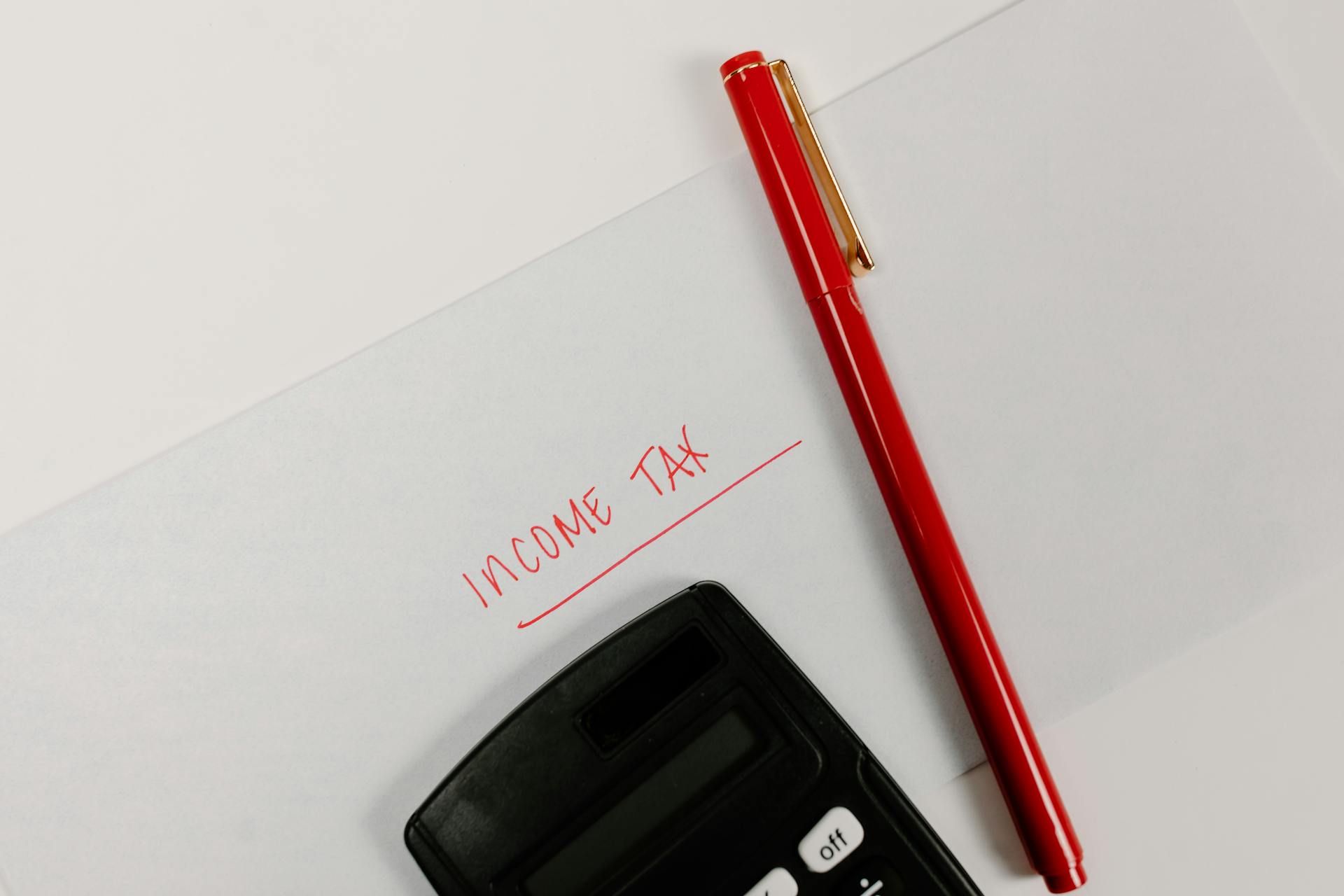
Car loans are a crucial part of buying a new vehicle, but have you ever wondered how they're calculated? The process is actually quite straightforward.
Lenders consider several factors when determining how much to lend you, including your income, credit score, and debt-to-income ratio. A good credit score can help you qualify for a lower interest rate.
In addition to your credit score, lenders also look at your debt-to-income ratio, which is the percentage of your monthly income that goes towards paying debts. This includes credit cards, student loans, and other loans.
A lower debt-to-income ratio can help you qualify for a higher loan amount. For example, if you have a debt-to-income ratio of 20% or less, you may be able to qualify for a larger loan.
See what others are reading: Do Deferred Student Loans Affect Debt to Income Ratio
How Car Loans Are Calculated
Car loans are calculated based on a few key variables, including purchase price and down payment. These two factors are crucial in determining the total amount you'll need to borrow.
The purchase price of the car is the starting point for calculating the loan amount. You can enter this variable into an auto loan calculator to see how it impacts your monthly payments.
A down payment is the amount you pay upfront, which reduces the loan amount and can lower your monthly payments. This amount is also a crucial input for an auto loan calculator.
The term of the loan, or how long you have to pay it back, is another important factor in calculating car loans. This can range from a few years to over a decade.
The interest rate on the loan also plays a significant role in determining your monthly payments. A higher interest rate can increase the total cost of the loan, making your monthly payments higher.
By entering these variables into an auto loan calculator, you can see how they impact your monthly payments and what it will take to pay off the loan.
If this caught your attention, see: What Is a High Interset Rate for Car Loans
Factors Affecting Loan Calculation
Several aspects of a loan contribute to what you'll pay monthly and in total. Our car financing calculator collects these values, so you can plan for what you'll be spending.
The interest rate is a key factor, and it varies based on your credit score. For example, if you have a superprime credit score (781-850), the average APR for a new car is 5.08%, while for a used car it's 7.41%.
Lenders also consider your credit history, car age, and other factors when deciding whether to approve a car loan and at what rate.
Here's a breakdown of average APRs by credit score:
Factors Affecting You
Your credit score plays a significant role in determining your interest rate, with Experian's 3rd quarter 2024 data showing average APRs ranging from 5.08% for superprime borrowers to 21.55% for deep subprime borrowers.
The type of car you're purchasing also impacts your loan, with new cars typically having lower APRs than used cars. For example, superprime borrowers can expect an average APR of 5.08% on a new car, while deep subprime borrowers face an average APR of 15.43%.
On a similar theme: How Long Are Car Loans for on Used Cars
The loan term is another crucial factor, with longer terms often resulting in lower monthly payments but more interest paid over the life of the loan. Our car financing calculator takes into account the loan term, so you can plan for what you'll be spending.
The purchase price and down payment amount also affect your loan, with higher purchase prices and lower down payments increasing the amount borrowed and interest paid.
The interest rate itself is a critical factor, with simple interest calculations front-loading monthly interest payments and resulting in more interest paid at the beginning of the loan. A higher interest rate means more interest paid over time.
Here's a summary of the factors affecting your car loan:
These factors all contribute to what you'll pay monthly and in total, making it essential to consider them when planning your car loan.
Trade-in Value
The trade-in value of your vehicle is a crucial factor in loan calculation. This value is not the same as the retail cost, which is the price the dealer sells the car for.
You can use online sites for appraisals and pricing help, such as CarMax or Carvana, to get a baseline for your trade-in value. These online retailers can also provide cash purchase offers to consider.
Make sure to check the trade-in value, not the retail cost, when using a pricing guide for your vehicle. This will give you an accurate estimate for your loan calculation.
Curious to learn more? Check out: Can You Trade in a Car While Financing
Vehicle Rebates
Vehicle rebates can significantly reduce the price of a new car, with some manufacturers offering rebates of up to $2,000 or more.
If you're purchasing a new car, make sure to check if the rebate is tax-free in your state, as some states don't tax cash rebates.
A good portion of states, such as Alaska, Arizona, and Massachusetts, don't tax cash rebates, so it's worth checking if you're eligible.
Some states do tax cash rebates, so be sure to factor that into your calculations when determining the final price of your car.
Rebates are typically only offered for new cars, although some used car dealers may offer cash rebates, which can be difficult to determine.
Curious to learn more? Check out: Heloc to Buy Investment Property Tax Deductible
Lender Reviews Application
Your credit score plays a significant role in the lender's decision-making process. The lender considers your credit score as part of your application.
Lenders will also take into account your credit history, which includes information about past payments and any outstanding debts. This helps them assess your creditworthiness.
A lender may also consider the car's age when reviewing your application. The age of the car can affect the loan amount and interest rate.
The lender will use these factors to decide whether to approve your car loan and at what rate.
Broaden your view: Refinance Auto Loan Bad Credit Upside down
Loan Calculation Process
To calculate a car loan, you'll need to enter variables such as purchase price, down payment, term, and interest rate into a calculator or use a tool like NerdWallet's auto loan calculator. This will give you a realistic view of what financing a car will cost, including an amortization schedule that breaks down how you'll pay off the loan over time.
You might enjoy: Will Insurance Cover Solar Shingles
The calculator will also take into account additional expenses such as state and local taxes, dealer documentation fees, and registration fees. You can search online, call your Department of Motor Vehicles, or contact a dealership to ask for average costs in your area.
Here are some key factors to consider when using an auto loan calculator: To find the lowest-cost loan, apply to several lenders for preapproved loan offers and enter interest rates and terms from the loan offers to narrow down your best option.To decide on a loan term, use the calculator to see your total loan cost with various loan terms and consider whether a shorter term is the better choice.
You might like: Typical Terms for Car Loans
Loan Calculation Process
To get the most out of an auto loan calculator, you need to understand the loan calculation process. This involves entering variables such as purchase price, down payment, term, and interest rate to see how they impact monthly payments.
The auto loan calculator takes into account a range of inputs, including loan amount, term, and rate, as well as down payment, trade-in value, and fees. This provides a detailed view of what financing a car will cost.
To use the calculator effectively, you should first gather all the necessary information about your car purchase. This includes the purchase price, down payment, and any trade-in value or fees.
The calculator can help you find the lowest-cost loan by allowing you to enter interest rates and terms from multiple loan offers. This can help you narrow down your best option and potentially save thousands of dollars.
You can also use the calculator to decide on a loan term. By comparing the total loan cost with various loan terms, you can see how a longer or shorter term affects your monthly payments and total interest paid.
Here's an example of how a longer loan term can increase your total interest paid: if you take out a $40,000 new car loan with an 84-month term at 9% APR, you would pay about $623 monthly and $12,369 in total interest over seven years.
Check this out: $10000 Upside down Car Loan
Vehicle Price
To calculate a fair vehicle price, you can start with the MSRP, or sticker price, of a new car.
Subtract any manufacturer rebates or savings from dealer negotiations to get a more accurate estimate.
The final price will also include extra costs, such as vehicle options and the "destination fee" charged on new cars.
For used cars, the seller's asking price might not be the final sale price, as you can often negotiate a lower price.
You can also research comparable cars online to get an idea of a fair price.
The asking price of a used car is just a starting point for negotiations, so don't be afraid to make an offer.
A unique perspective: How to Use a Heloc to Buy a New Home
Calculating EMI
Calculating EMI is a crucial step in understanding how car loans work. The Equated Monthly Instalment (EMI) includes both the principal amount and interest.
To calculate EMI manually, you can use the formula: P x R x (1+R)^N / [(1+R)^N-1], where P is the principal amount, R is the rate of interest, and N is the number of monthly instalments. This formula can be found in Example 2.
The EMI is fixed through the loan tenure and repaid monthly. You can also use an online car loan EMI calculator to simplify the process.
Here's a breakdown of the variables involved in calculating EMI:
For example, if you take out a $40,000 new car loan with an 84-month term at 9% APR, you would pay about $623 monthly and $12,369 in total interest over seven years. Shortening the term to 60 months would increase the monthly payment to $811, but it would reduce your total interest paid to $8,600.
Frequently Asked Questions
What is 6% interest on a $30,000 loan?
The interest on a $30,000 loan at 6% is $2,856 over 36 months. This translates to approximately $79 per month in interest payments.
Featured Images: pexels.com


